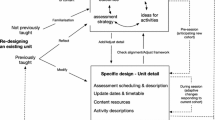Abstract
Research on teacher thinking and teacher planning conducted over the past few years suggests that teachers rarely proceed in a “systematic” fashion when planning or carrying out instruction. What happens when teachers become designers of instructional materials? In a series of studies of teachers and novice instructional designers, data were collected on: the form taken by initial ideas for materials; elements involved in initial thinking; constraints perceived; the train of the design process; and reflections on the design after completing it. Results showed that prescriptive models of how instructional design should proceed frequently do not match the reality of instructional design in practice. Several changes in instructional design procedures might take these differences into account: designers might engage in “synectics” sessions, for example, rather than focusing immediately on objectives. And incompleteness in a design appears to have particular fascination for instructors. Finally, the studies point out the need for more careful and comprehensive treatments of what “design” is, and of why some are more successful at it than others.
Similar content being viewed by others
References
Arieti, S. (1976). Creativity: The Magic Synthesis. New York: Basic Books.
Bresson, R. (1977). Notes on Cinematography. New York: Urizen.
Clark, C. (1978/79). “A new question for research on teaching,” Educational Research Quarterly 3 (4): 53–58.
Clark, C. (1980). “Choice of a model for research on teacher thinking,” Journal of Curriculum Studies 12 (1): 41–47.
Clark, C. and Yinger, R. (1977). “Research on teacher thinking,” Curriculum Inquiry 7 (4): 279–304.
Clark, C. and Yinger, R. (1979a). “Research on teacher planning: a progress report,” Journal of Curriculum Studies 11 (2): 115–177.
Clark, C. and Yinger, R. (1979b). Three Studies of Teacher Planning. Research series no. 55 East Lansing, MI: Michigan State University, Institute for Research on Teaching.
Clark, C. and Yinger, R. (1980). “The Hidden World of Teaching.” Paper presented to the annual meeting of the American Educational Research Association, Boston, MA, April.
Doyle, W. and Ponder, G. (1977/78). “The practicality ethic in teacher decision making,” Interchange 8 (3): 1–12.
DuBois, N., Alverson, G. and Staley, R. (1979). Educational Psychology and Instructional Decisions. Homewood, IL: Dorsey.
Eastman, C. (1973). “On the analysis of intensive design processes,” in G.Moore (ed.), Emerging Methods in Environmental Design and Planning. Cambridge, MA: MIT Press.
Gage, N. and Berliner, D. (1979). Educational Psychology. Second edition. Chicago: Rand McNally.
Harrison, A. (1978). Making and Thinking: A Study of Intelligent Activities. Indianapolis, IN: Hackett.
Jackson, P. (1966). The Way Teaching Is. Washington: National Education Association.
Jackson, P. (1968). Life in Classrooms. New York: Holt.
Joyce, B. (1978/79a). “Research into the teaching mind: a vital direction,” Educational Research Quarterly 3 (4): 10–15.
Joyce, B. (1978/79b). “Toward a theory on information processing teaching,” Educational Research Quarterly 3 (4): 66–77.
Joyce, B. and Harootunian, B. (1964). “Teaching as problem solving,” Journal of Teacher Education 15 (4): 420–427.
Macdonald, J. (1965). “Myths about instruction,” Educational Leadership 22 (8): 571–576, 609–617.
Mager, R. (1975). Preparing Instructional Objectives. Second edition. Belmont, CA: Fearon.
McCutcheon, G. (1979). “How Elementary School Teachers Plan Their Curriculum: Findings and Research Issues.” Paper presented at the annual meeting of the American Educational Research Association, San Francisco, CA, April.
Powell, M. (1979). “Studies of ‘how teachers think’: a new need for teacher involvement in research,” Educational Research Quarterly 4: 5–11.
Shavelson, R. (1976). “Teacher decision making,” in N.Gage (ed.), The Psychology of Teaching Methods. 75th yearbook of the NSSE. Part I. Chicago: University of Chicago Press.
Taylor, P. (1970). How Teachers Plan Their Courses. London: National Foundation for Educational Research.
Taylor, W. (1980). “Teacher and materials: the selection process,” in M.Cambre (ed.), Secondary School Video. Bloomington, IN: Agency for Instructional Television.
Taylor, W. and DiPaolo, A. (1978a). “Project Discovery revisited: was it worth it?” Audiovisual Instruction 23 (6): 16–18, 55.
Taylor, W. and DiPaolo, A. (1978b). “Project Discovery revisited: managing for accessibility,” Audiovisual Instruction 23 (7): 17, 61.
Tom, A. (1973). “Teacher reaction to a systematic approach to curriculum implementation,” Curriculum Theory Network 11: 86–93.
Toomey, R. (1977). “Teachers' approaches to curriculum planning: an exploratory study,” Curriculum Inquiry 7 (2): 121–129.
Tyler, R. (1950). Basic Principles of Curriculum and Instruction. Chicago, IL: University of Chicago Press.
VanManen, M. (1977). “Linking ways of knowing with ways of being practical,” Curriculum Inquiry 6 (3): 205–228.
Yinger, R. (1980). “A study of teacher planning,” Elementary School Journal 80: 108–127.
Zahorik, J. (1970). “The effect of planning on teaching,” Elementary School Journal 71 (3): 143–151.
Zahorik, J. (1975). “Teacher planning models,” Educational Leadership 33 (2): 134–139.
Author information
Authors and Affiliations
Additional information
Paper prepared for presentation at the Annual Meeting of the Association for Educational Communications and Technology, Philadelphia, PA, April 7, 1981.
Rights and permissions
About this article
Cite this article
Kerr, S.T. How teachers design their materials: Implications for instructional design. Instr Sci 10, 363–378 (1981). https://doi.org/10.1007/BF00162734
Issue Date:
DOI: https://doi.org/10.1007/BF00162734




